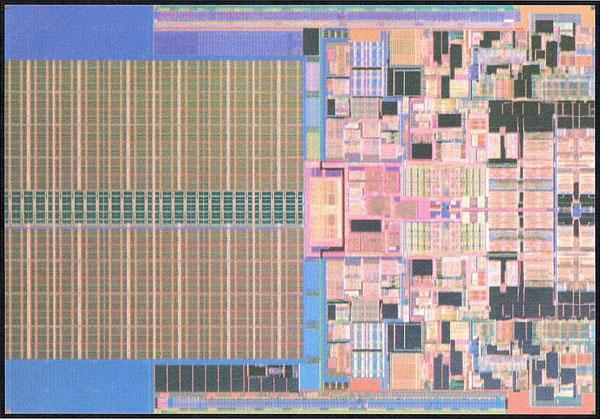Intel Corp. said this week that it remains on track to begin producing its next-generation Penryn family of processors in the second half of this year, marking the next step in its "tick-tock" product rhythm of delivering a new process technology or entirely new microarchitecture every year.
The Santa Clara-based firm said it holds more than 15 45nm Hi-k product designs in various stages of development, and will have two 45nm manufacturing fabs in production by the end of the year, with a total of four in production by the second half of 2008 that will deliver tens of millions of these processors.
Below are many of the details of the Penryn processor family and a glimpse into some of the key features of Intel's future generation of processors, codenamed Nehalem.
Penryn Family Microarchitecture Innovations
- Microarchitecture Optimizations — Increases the overall performance and energy efficiency of the already leading Intel Core microarchitecture to deliver more instruction executions per clock cycle, which results in more performance and quicker PC responsiveness.
- Enhanced Intel® Virtualization Technology — Penryn speeds up virtual machine transition (entry/exit) times by an average of 25 to 75 percent. This is all done through microarchitecture improvements and requires no virtual machine software changes. Virtualization partitions or compartmentalizes a single computer so that it can run separate operating systems and software, which can better leverage multicore processing power, increase efficiency and cut costs by letting a single machine act as many virtual "mini" computers.
- Higher Frequencies — Penryn family of products will deliver higher overall clock frequencies within existing power and thermal envelopes to further increase performance. Desktop and server products will introduce speeds at greater than 3GHz.
- Fast Division of Numbers ? Penryn-based processors provide fast divider performance, roughly doubling the divider speed over previous generations for computations used in nearly all applications through the inclusion of a new, faster divide technique called Radix 16. The ability to divide instructions and commands faster increases a computer's performance.
- Larger Caches — Penryn processors include up to a 50 percent larger L2 cache with a higher degree of associativity to further improve the hit rate and maximize its utilization. Dual-core Penryn processors will feature up to a 6MB L2 cache and quad-core processors up to a 12MB L2 cache. Cache is a memory reservoir where frequently accessed data can be stored for more rapid access. Larger and faster cache sizes speed a computer's performance and response time.
- Unique Super Shuffle Engine — By implementing a full-width, single-pass shuffle unit that is 128-bits wide, Penryn processors can perform full-width shuffles in a single cycle. This significantly improves performance for SSE2, SSE3 and SSE4 instructions that have shuffle-like operations such as pack, unpack and wider packed shifts. This feature will increase performance for content creation, imaging, video and high-performance computing.
Photo of the Intel Penryn Die
Nehalem Microarchitecture
After Penryn and the 45nm Hi-k silicon technology introduction comes Intel's next-generation microarchitecture (Nehalem) slated for initial production in 2008. By continuing to innovate at this rapid cadence, Intel will deliver enormous performance and energy efficiency gains in years to come, adding more performance features and capabilities for new and improved applications. Here are some new initial disclosures around our Nehalem microarchitecture:
- Dynamically scalable for leadership performance on demand with energy efficiency
- Dynamically managed cores, threads, cache, interfaces and power
- Leverages leading 4 instruction issue Intel® Core microarchitecture technology
- Simultaneous multi-threading (similar to Intel® Hyper-threading technology) returns to enhance performance and energy efficiency
- Innovative new Intel® SSE4 and ATA instruction set architecture additions
- Superior multi-level shared cache leverages Intel® Smart Cache technology
- Leadership system and memory bandwidth
- Performance enhanced dynamic power management
- Design scalable for optimal price/performance/energy efficiency in each market segment
- New system architecture for next-generation Intel processors and platforms
- Scalable performance: 1 to 16+ threads, 1 to 8+ cores, scalable cache sizes
- Scalable and configurable system interconnects and integrated memory controllers
- High performance integrated graphics engine for client
 AppleInsider Staff
AppleInsider Staff







-m.jpg)






 Marko Zivkovic
Marko Zivkovic
 Malcolm Owen
Malcolm Owen


 William Gallagher
William Gallagher
 Amber Neely
Amber Neely
 Sponsored Content
Sponsored Content

-m.jpg)






54 Comments
I just read a press release on Macsurfer. When are these things supposed to be out?
I just read a press release on Macsurfer. When are these things supposed to be out?
Should be next year. Intel is rockin', they say they want to unveil a new core change every two years. That doesn't necessarily mean they are shrinking the die but the core will improve.
Next they're opening up a new foundry in China. I'm happy with this forward progress but quite honestly I am hoping that AMD does very well. Since AMD has become a force in microprocesor Intel has had to fight harder and drop prices faster. This is good for us all.
Imagine a 13.3 Macbook Pro with integrated GPU and ondie memory controller running Penryn. We'll likely see laptops with support for 8GB of RAM or more.
Looks like we had a lull in microprocessor design over the last few years but it's rebounding with alacrity.
Should be next year. Intel is rockin', they say they want to unveil a new core change every two years. That doesn't necessarily mean they are shrinking the die but the core will improve.
Next they're opening up a new foundry in China. I'm happy with this forward progress but quite honestly I am hoping that AMD does very well. Since AMD has become a force in microprocesor Intel has had to fight harder and drop prices faster. This is good for us all.
Imagine a 13.3 Macbook Pro with integrated GPU and ondie memory controller running Penryn. We'll likely see laptops with support for 8GB of RAM or more.
Looks like we had a lull in microprocessor design over the last few years but it's rebounding with alacrity.
Your wishes for AMD don't seem to be coming true...
Just as well for me... I've owned INTC for some time. Hopefully it roars back with a vengeance.
Your wishes for AMD don't seem to be coming true...
Ouch. AMD better get the K8L out fast. Intel is trying to sprint away.
http://www.intel.com/pressroom/archi...070328fact.htm
NEHALEM MICROARCHITECTURE
After Penryn and the 45nm Hi-k silicon technology introduction comes Intel's next-generation microarchitecture (Nehalem) slated for initial production in 2008. By continuing to innovate at this rapid cadence, Intel will deliver enormous performance and energy efficiency gains in years to come, adding more performance features and capabilities for new and improved applications. Here are some new initial disclosures around our Nehalem microarchitecture:
Dynamically scalable for leadership performance on demand with energy efficiency
Dynamically managed cores, threads, cache, interfaces and power
Leverages leading 4 instruction issue Intel® Core microarchitecture technology
Simultaneous multi-threading (similar to Intel® Hyper-threading technology) returns to enhance performance and energy efficiency
Innovative new Intel® SSE4 and ATA instruction set architecture additions
Superior multi-level shared cache leverages Intel® Smart Cache technology
Leadership system and memory bandwidth
Performance enhanced dynamic power management
Design scalable for optimal price/performance/energy efficiency in each market segment
New system architecture for next-generation Intel processors and platforms
Scalable performance: 1 to 16+ threads, 1 to 8+ cores, scalable cache sizes
Scalable and configurable system interconnects and integrated memory controllers
High performance integrated graphics engine for client
Oops I had that backwards. Penryn start manufacturing this year 2H and then Nehalem takes over next year. That does give AMD a bit of time to get out their Fusion product (CPU/GPU) and Torrenza.
How would you like a .45nm chip with SMT and ondie memory controllers and integrated GPU?
Welcome to Torrenza lite. This is fabulous news for those who love mobile computing and great news potentially for ?tv2
It better have something better then FSB if intel when to put all of that in a cpu.